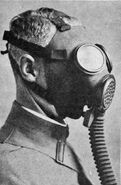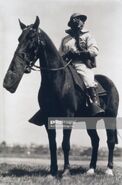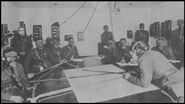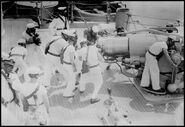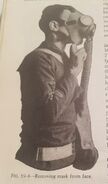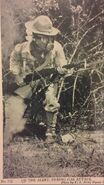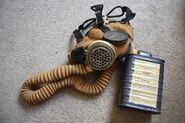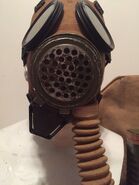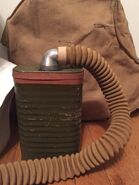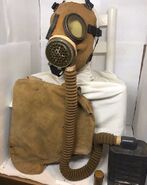
MI-I-II diaphragm gas mask
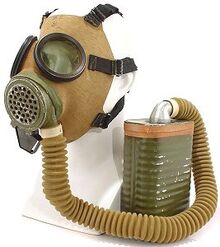
MIA1-IV-III diaphragm gas mask. this photo belongs to the Collection of Bart Wilkus
Development[]
Towards the end of World War I and shortly after the standardization of the MI-I-II Service gas mask. The army was looking to develop a new diaphragm mask design. Designs were tossed around one mask being standardized as the Navy 1922 Type ND mask. Toward the mid 1920s a New diaphragm mask design known as experimental diaphragm mask 3-3-2. The facepiece was assembled using a flat sheet of brown gum rubber with a stockinette vulcanized onto the sheet rubber. The rest of the hardware i.e lens crimpings was added afterwards. The final step was the facepiece being joined together at the chin. It would have a wider Opening to account for the new diaphragm angle to assembly. it would be standardized in 1925 as the MI-I-II diaphragm gas mask. The mask was issued in five different sizes.
Ml diaphragm gas mask[]
In 1925 the MI diaphragm gas mask was first issued. The configuration was the (MI-II-II diaphragm gas mask).The mask was issued in five different sizes. Facepiece was made of a red brown gum rubber. The Ml diaphragm mask also used two types of head harnesses. The Ml was adjusted from the head pad with the straps sewn to the facepiece tabs. The Mll was adjusted from the facepiece. Later production MI diaphragm masks also used the MII Felt filter (MI-II-II diaphragm gas mask) The MI diaphragm mask Used the MII Outlet valve. Some early Ml diaphragm masks used a black rubber band to cover the wire and tape around the diaphragm angle tube assembly. The Navy also used a variant of the MI Diaphragm mask. this variant was referred to as the MkI Navy diaphragm gas mask there are no differences between the two. A lot of MkI Navy diaphragm masks are found with MIII Coil spring head harnesses because the Navy preferred them over the MII Cloth head harness.. Later navy configurations used blue navy filters to replace the old and outdated army filters.
MIAI diaphragm gas mask[]
In 1928 the first and last alteration to the facepiece was made resulting in threaded lenses so the lenses could be replaced. It would still use the MII Head harness and the MII Outlet valve. just like the MI diaphragm mask the Facepiece was made of a red brown gum rubber. This new Facepiece would also be issued with a new filter known as the MIV which had an inlet valve on the bottom rather than the top like the MII felt filter. A new carrier was issued known as the MIII. It was meant for filters with inlet valves on the bottom. The Resulting kit would be designated MIA1-IV-III diaphragm gas mask. Just like the M Idiaphragm gas mask. The Navy also used a variant of the MIA1 Diaphragm mask. this variant was still referred to as a MkI Navy diaphragm gas mask there are no differences between the two. A lot of MkI Navy diaphragm masks are found with MIII Coil spring head harnesses because the Navy preferred them over the MII Cloth head harness. These are also still found with Blue navy Filters that were used to replace the old and dated army canisters.
Last uses and packaging of the masks[]
In 1941 the MI diaphragm mask was a limited standard, the MIA1 was a standard in size 1 The MI series masks (MI, MIA1) were in service until 1944 and were declared obsolete by the end of the war. In storage, the masks were sealed in a metal tin. Faceforms were used to keep the facepiece from getting disformed in storage. The Ml and MlA1 used the Ml face form. Early on, the MI and MIA1 diaphragm gas masks were stored in an MI tin. Later on the later production MIA1 diaphragm masks were stored in a MII tin. The reason for this is because it would keep the masks from getting damaged in storage and kept moisture out of the filters.
Service Canisters[]
MI Felt Filter (1919/MI Felt Filter): Standardized in 1919 and is a blue painted filter with two inlet valves located at the top covered by a rain guard. The canister is made up of two parts, the inner perforated tin canister which holds the charcoal mixture and the outer casing of the canister. A 4,76 mm (3/16) inch thick wool felt material encases the inner perforated tin canister which holds a mixture of soda-lime granules and charcoal. Within the middle of the inner canister is a wedge-like tube that leads to the shank of the canister and is lined with a thin cloth to prevent any charcoal dust from being inhaled. MII Felt Filter: Similar dimensions as an MI felt filter externally but had an OD painted rain cover over the inlet valve on the top of the filter instead of being blue like on the MI. The filter ingredients remained mostly the same but the felt filter part was impregnated to increase protection against toxic smoke. The MIV filter which was an OD green color has the inlet valve located at the bottom with a curved elbow tube. A wrapping of adhesive tape stops leakage and secures the top to the MIV canister body. The internal components of the canister consists of a particulate filter which is referred to as a “sucked on” cotton linter particulate filter. This layer was essentially a mesh screen with trapped cotton fibers. It was made using the same principle as a lint catcher used in a dryer. The particulate filter enclosed the internal chemical canister which encased a charcoal mixture of 20% soda-lime by volume and 80% Type A (copper-impregnated) charcoal. The filling was held in place by a sheet metal plate pressed against the filling by a spring.The chemical container holds 615 ml.
Service Carriers[]
Only two carriers were issued with the M1 diaphragm series. The MI Diaphragm mask was first issued with the MII carrier which had no tuck in the bottom and was meant for filters with their inlet valves located at the top. The MIA1 diaphragm mask was issued with a MIII carrier Which had a tuck in the bottom and was meant for filters with inlet valves at the bottom.
Markings[]
The MI Diaphragm mask was issued in Five size with the number being stamped on the forehead. The MIA1 Was issued in four sizes with US and the number on the forehead .



